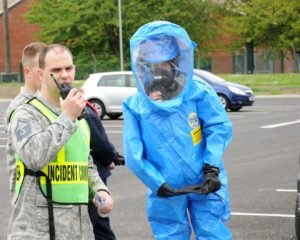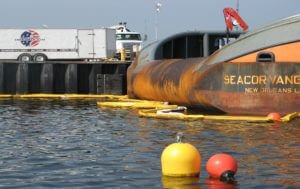Contents
SAFE TRANSPORTATION OF CHEMICALS
Transportation of Hazardous Material: Transportation is by road, rail, water or air. Containers are mostly standardized to ensure safety during transit. When a truck or tanker meets with accidents or leaks on the way, it creates problem. Fire or explosion can cause harm to public or property. Corrosive or toxic chemical can cause harm to public, animals, birds and environment. Sometimes grave emergency is created. Warning to public; speedy rescue operation, evacuation and calling helping hands may become necessary. While considering transportation of chemicals one has to consider the physical and chemical properties of the product being handled, whether it is a solid, a powder, a liquid or a gas under pressure; the type of packing, hazards, and the mode of transport available. Before transfer or transportation of chemicals, their modes of packaging should be considered.
Modes of Packaging
(1) Glass bottles and carboys are some of the oldest packaging available for corrosive liquids, solvents etc. Some of the bulk industrial materials still being transported in bottles are Bromine, Mercury etc. The laboratory reagents and pure grade chemicals are also transported in glass bottles of various sizes. Many corrosive chemical like Nitric acid, Sulphurylchloride, thionylchloride e&., are transported in glass carboys holding 2560 kg of the material. These glass bottles & carboys have to be properly protected against shocks. Wooden crates for carboys, plastic or paper Backing for bottled is usual. Dangerous chemicals are further protected by packing in clay or other absorbent material so that in case the bottle breaks, the chemical .s absorbed and causes least damage.
(2) Plastic bottles, jars, carboys and drums: these could be constructed out of polythene either of low density or high density, PVC or other materials. Quite a lot of chemicals ranging from laboratory chemicals to industrial raw material are being packed and transported in plastic containers. These containers may be further protected by wooden cases. The material must be correctly chosen. Several tragedies have occurred because, on long storage the plastic containers became brittle and the chemical leaked out
(3) Steel drums n various sizes have been used for storage and transportation of solvents and chemicals. Even corrosive chemicals like chlorosulphonic acid are shipped in steel containers. This is quite a common packing for chemicals of all description; and quite economical too. Recently polythene and PVC liners, as well as polythene lined drums, have been made available and these are used for packing even highly corrosive materials like hydrochloric acid. Proper sealing of the drums is essential.
(4) Bags of various types: Jute bags and paper bags are used for the innocuous chemicals like Soda ash, salt Kieselguhr, etc. Polythene lined jute bags have been used for the materials which need to be protected against moisture: Woven high density polythene bags are being used or packing corrosive and water sensitive materials like Caustic Soda and Caustic Potash. Obviously this packing cannot stand piercing and must be well protected and handled such that the bags are not damaged. In transport, the bags must be properly stacked and secured.
(5) Gases under pressure in cylinders: Quite a few gases like Chlorine, Sulphur dioxide, Ammonia Ethylene oxide, oxygen etc, are sold in cylinders containing quantities ranging from 50-100 KGs Steel cylinders are the commonest, but various kinds if linings are also given for special products. The rules governing the design, testing and filling of cylinders are quite elaborate and must be followed.
The service equipment such as valves, fittings, gauges etc. should be protected against impact. Three types of independent step valves- internal, external and blind flange are required. For certain gases like HF, shell opening at bottom is not permitted. Fusible plug to operate below 93 °C is suggested in case of petroleum tanker. Spark arrester on exhaust a portable fire extinguisher, TREMCARD emergency kit and instructions to driver are also necessary.
Emergency Planning for Transport of Hazardous Chemicals

Various directives and recommended actions have been issued by international organizations like UN Committee of experts on the transport of dangerous goods, European Economic Committee (EEC) US Department of Transport etc. They need special labels or notices on packages or on vehicles, display of correct technical name of the chemical, special signs or ,plates, instruction in writing to the drivers i.e. TREM CARD (Transport Emergency Card), safe packing conditions, particulars in transport documents display of supplier’s name, address and phone number including phone number form where specialist advice an be available.
Master tests of some 400 TREMCARDS of hazardous substances are readily available from Chemical industries Association of UK. ICMA of our country should also provide such cards in Indian languages.
The content of a ‘Tremcard’ should include name of cargo (material), nature of Its hazard protective devices including PPE and emergency action to (1) inform Police and Fire Brigade (2) Spill or gas control (3) Fire control and (4) First aid
The transporter should carry ‘Emergency kit’ containing tool kit, emergency lighting fire extinguisher, protective clothing, breathing equipment and first aid kit.
Proper training to drivers of hazardous chemicals is legally required. Safety checklist or transport vehicles shall be prepared and used. Tramcard should b given to workers.
Emergency Action:
In case of toxic release

- Driver of hazardous cargo should be trained to handle small emergencies.
- Inform police, fire brigade and manufacturer.
- Takeout tremcard, MSDS etc. from vehicle and give it to police.
- Vehicle should be taken in open area and parked away from thickly populated area.
- Cordon the area around leak.
- Stop traffic and keep people away from the vehicle.
- Leaking liquid can be contained in bunds of sand/earth.
- Small leaks can be plugged by wooden peg.
- If a leak is from cylinder valve it can be capped by yoke clamp.
- A leaking cylinder can be turned so as to bring leaking portion in gas phase.
- Water is not to be added on leaking cylinder and spill if chemical is corrosive.
- Use water sprays, fogs to absorb toxic vapour cloud.
- Evacuate the downwind area in case of large toxic leakage.
In case of inflammable chemicals
- Park vehicle on the road side.
- Stop engine.
- Inform police, fire brigade and manufacturer.
- Takeout tremcard, MSDS etc. from vehicle and give it to police.
- Cordon off the area, stop traffic and keep people away.
- Do not smoke Ignition source to be avoided.
- In case of fire, try to extinguish it with fire extinguisher.
- Try to stop leak by cutting off the source, close valve.
- Keep the tank cool by water sprays to avoid explosion.
- Surrounding area should be checked fire explosion possibility and evacuated if necessary.
For Threshold Quantities of handling (including transport! transfer) chemicals and applicability)
Water Transport

Quite a lot of chemicals are transported by ocean going ships an on river tugs. Crude oil products, natural gas and other dangerous goods are some of the biggest bulk commodities in international commerce. Because of their huge quantities involved, pillage and leakage can create gigantic pollution problems, besides a fire hazard. There have been several mishaps of this type Tanker design has assumed Special safeguards being made to prevent accidental spillage.
When solid chemicals are transported, care should be taken that e material will not cake up because of moisture, so that it may require to be emptied pneumatically. When carrying drums or cylinders they should be properly lashed so as not to break loose. In river transport, spillage of chemicals may cause very serious pollution problems.
The carriage of dangerous goods by sea is day by day increasing. About 4000 million tonnes cargo enters world seaborne trade every year, of which about 100 million tonnes are dangerous goods in packaged form. More than 1 lac types of hazardous chemicals are transported b sea. They include solid, liquid and gases in bulk. While cutting oil-tanks and pipelines on ships at Alang shipyard (Bhavnagar) many fatal accidents have taken pl cc. Thus these are the end problems even after transportation by sea.
International maritime Organization (IMO), International Convention for the Safety Of Life At Sea. 1974 (SOLA ‘74) and international Concern Lion for the Prevention of Pollution from Ships, 1973 (MARPOL 73) have developed guidelines and codes for carriage of dangerous goods in packaged form by sea.
IMO as formulated International Maritime Dangerous Goods (IMDG) Code and ‘Emergency Procedures r Ships carrying dangerous goods (EmS)’.
SOLA has formulated ‘Code of safe Practice for the Shipment. of Bulk Cargoes (BC Code)’ for transmutation of dangerous solid goods in bulk.
Medical First Aid Guide (MFAG) for use in accidents involving dangerous goods is available in lMO/WH /ILO publication. lMO/ILO guidelines for packing cargo in Freight Containers or Vehicles and IM0 recommendations on safe use of pesticides in Ships are also available.





